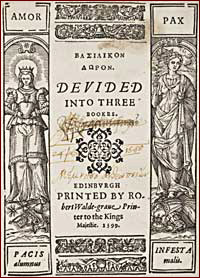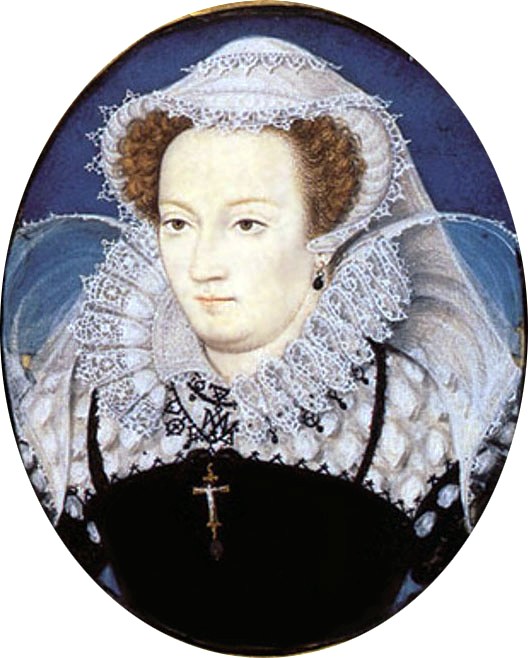 |
| Esme Stuart |
The Catholic
Esmé, Seigneur d’Aubigny, was visiting Scotland to deal with a dispute over the
earldom of Lennox. The 37 year old father of four was an instant hit with the
young king. James was fascinated by Esmé’s sophistication and the two would sit
up late laughing and drinking. Esmé gave James affection and James responded
with devotion. Esmé encouraged James to write to his mother
Esmé was
able to re-order the Scottish court on the French model and encouraged James
interest in poetry. In return Esmé joined the Privy Council and was made Earl
of Lennox on 5th March 1580 and on 5th August 1581 he was
made Duke of Lennox. At the same time as he was upsetting the Scottish nobles
by his rise Lennox was propitiating the Scottish burghs[i].
Lennox was persuaded by James to change his
religion in an attempt to reduce hostility to his Catholic favourite. The
English envoy Sir Henry Widdrington was horrified by Lennox’s growing
power[ii];
‘He [James] can hardly
suffer him out of his presence, often times he will clasp him about the neck,
with his arms and kiss him.’[iii]
The Kirk
went further;
‘The Duke of Lennox went
about to draw the King into carnal lust.’[iv]
Basilikon Doron
It is
impossible to know whether Lennox and James, or indeed any of the King’s future
favourites knew each other in carnal
lust. But, despite James’ advice in the Basilikon Doron[v], addressed to Charles, condemning
homosexuality as a sin;
‘That ye are bound in
conscience never to forgive,’[vi]
James was
well known for his blasphemous oaths and failure to live up to much of the
advice he gave Charles
Malign Influences
Earl of Lennox
Lennox’s boon companion James Stewart was made Earl of Arran; the two men
persuaded James to have Morton tried for his part in the murder of James’
father. Found guilty Morton was executed on 2nd June 1581.
The Kirk and
its supporters viewed the triumvirate of Lennox, Arran and James with
disfavour, especially as Lennox encouraged James to believe that the church was
encroaching on his authority.
Elizabeth made a formal approach to James
demanding that he remove ‘the professed Papist’ Lennox. Although normally wary
of offending Elizabeth James ignored her demand.
Kirk and
king fell out over James’ choice of Robert Montgomery as Bishop of Glasgow. The
nominee was unacceptable in the eyes of the Presbyterian general assembly. On the 22nd August 1582
James was kidnapped by the Earl of Gowrie in what became known as the Ruthven raid.
Ruthven Castle
James was
forced to issue a proclamation against Lennox and Arran. The Master of Glamis ignored James’ tears of humiliation
and loss, saying;
‘Better that bairns should weep than bearded men.’[vii]
The
heartbroken James wrote a heartfelt poem bemoaning his loss as Lennox returned
to France[viii], whilst his subjects
railed against Lennox who had, according to Andrew Melville, held the king,
‘In a misty night of captivity
and black darkness of shameful servitude.’[ix]
Those
opposing James and Lennox did so more for political purposes rather than moral
indignation. Lennox had been spending money like water and Gowrie was owed
£33,000[x]. The regime cut James’
household expenses claiming;
"Havand respect to the
order of the hous of your hieness goudsire King James the fifth of worthie
memorie and to the possibilitie of your majesties present rents,"[xi]
The Gowrie
regime was supported, somewhat ineffectually by Elizabeth and the French court,
hoping to influence the choice of James’ bride, offered Gowrie a pension[xii].
But the
Earls of Gowrie and Mar and their supporters did not enjoy the heady experience
of power long. They moved James around the country but the backlash was headed
by James’ supporters. A consortium of lairds including the earls of Atholl, Huntly[xiii], Montrose, Crawford and Rothes rescued James from his kidnappers in
July 1583.
The Gowrie
regime and their followers were dismissed from court and James was finally in
control. In May 1584 Gowrie was executed after conspiring again against James
and at this point the Casket Letters fell into government hands.
The King’s Mother
20 year old James
One of the
biggest problems facing James upon his assumption of power was the vexed issue
of his mother, still a prisoner in England. When his mother’s emissary,
Monsieur de Fontenay, visited James’ court in August 1584 he was astonished
that James asked no questions about his mother;
‘Neither of health, nor of
the way she is treated, nor of her recreation nor of any similar manner.’[xiv]
Fontenay
judged James;
‘Three qualities of mind he
possesses in perfection: he understands clearly, judges wisely and has a
retentive memory……….overconfident of his strength and scornful of other princes.’[xv]
Mary by Nicholas Hilliard
But James
had been so indoctrinated in his youth that he had no filial feelings for his
mother, viewing her solely as a threat to his throne. He was able to deride
Buchanan for the lies told in his Detectio
and in his Basilikon James castigated
Moray for his unnatural rebellion against his half-sister, but James’
upbringing had assured that he was unable to love his mother. And Mary’s
messenger, Patrick Gray[xvi], saw which way the wind was blowing
and switched over to support James.
Ruling Alone
James was
profligate and spent money with abandon; Elizabeth paid him a total of £58,000[xvii] in the years from 1586
to her death. Mary’s hope that her son would invite her home[xviii] was dashed by the Treaty of Berwick signed on 6th July 1586,
which granted James a pension of £4,000 per annum[xix]. It is believed by some
that the treaty was meant to soften the blow of Mary’s death.
The question
of religion also reared its ugly head; a decision taken during James’ minority
to allow a limited form of episcopacy was not to the taste of Andrew Melville,
an ecclesiastical leader who believed that the Scottish church should follow
the true Presbyterian model without bishops.
Andrew Melville
In 1561 a
form of bishops or superintendants had been allowed but in 1581 this was
reversed under Melville’s influence. Melville held that it was up to the clergy
to;
‘Teach the magistrate
[James].’[xx]
But in 1584,
after Gowrie’s fall, the monarch was reaffirmed as head of the church. As Archbishop
of St Andrews, Patrick Adamson’s influence expanded whilst that of
Melville’s diminished; he fled to England after being summonsed to be tried for
seditious preaching.
The
Extremist lairds, exiled after the overthrow of the Ruthven coup, were returned
to Scotland by Elizabeth. They challenged Arran’s power and James was forced to
remove Arran from his post as chancellor. Although obliged to pardon the
exiles, James was still able to hold his kingship above them.
The Death of Mary
Following
her involvement in the Babington Plot, an attempt to overthrow Elizabeth and place Mary on the
throne, the stage was set for Mary’s final scene. On 25th September
1586, less than three months after the signing of the Treaty of Berwick, Mary
was transferred to Fotheringhay castle to await trial. Thirty six commissioners assembled
there on 11th October to try Mary, who declared that
‘It seemeth strange to me,
that the Queen should command me as a subject, to submit my self to a Trial. I
am an absolute Queen, and will doe nothing which will be prejudicial to Royal
Majesty, or to other Princes of my place and rank, or my son.’[xxi]
Nevertheless
the trial took place on 15-16th October after an intervention by
Elizabeth. Mary denied all the charges but the result was a foregone
conclusion. Before the commissioners were able to give their verdict a message
from Elizabeth arrived proroguing the outcome to the Star Chamber at Westminster. There on 25th October Mary was
found guilty and on the 29th parliament ratified the verdict and
pressed for Mary’s execution.
Contemporary sketch of Mary's execution
The warrant for
the execution was finally signed on 7th February 1587 and Mary was
told to prepare for death the next day. It is possible that James communicated
to the English that he would not sacrifice the alliance between the two
countries in the event of his mother’s death.
When he was
informed of his mother’s death by her servants James cut all communication
between Scotland and England. Elizabeth sent her cousin Sir Robert Carey to James; he carried a letter from
Elizabeth in which she swore that she had signed the death warrant on the
understanding that it was only to be used in the event of an invasion force.
Carey was forced to wait at the border for days before James agreed to see him.
Bibliography
The Early
Stuarts – Godfrey Davies, Oxford University Press 1987
Elizabeth
& Mary – Jane Dunn, Harper Perennial 2003
King James –
Antonia Fraser, BCA 1974
Mary Queen
of Scots – Antonia Fraser, Weidenfeld and Nicholson 1978
Robert Cecil
– Alan Haynes, Peter Owen Publishers 1989
Walsingham –
Alan Haynes, Sutton Publishing 2004
After
Elizabeth – Leanda de Lisle, Harper Perennial 2006
Mary, Queen
of Scots – Alison Weir, BCA 2003
[i].
In July 1580, the English diplomat Robert Bowes reported that Lennox had
obtained fishing rights in Aberdeen, which the deposed Regent Morton had
formerly given to his servant George Affleck of Balmanno, and then he arranged
for the King to give this valuable source of income to the town
[ii]
A faction at the English court feared that Lennox was the forerunner of an
attack on England from Scotland, led by the powerful de Guise family; Esmé
had been escorted to his ship bound for Scotland by the Duc de Guise
[iii]
After Elizabeth – de Lisle
[iv]
Ibid
[v]
Originally meant for Prince Henry the Basilikon reiterated James’ belief in the
Divine Right of
Kings and criticised both Catholics and Protestants. It advised on dress
and behaviour of the monarch
[vi]
Ibid
[vii]
King James - Fraser
[viii]
Dying in Paris in May 1583
[ix]
King James - Fraser
[x]
This is Scottish pounds and the calculation of worth is in English pounds; In 2011, the
relative value of £33,000.0s.0d from 1582 ranges from £7,802,000.00 to
£2,382,000,000.00 www.measuringworth.com
[xii]
A yearly pension of 100,000 crowns for the state, 2,000 crowns personally, and
a lump sum of 10,000 crowns
[xiii]
Later Marquess of Huntly
[xiv]
King James - Fraser
[xv]
After Elizabeth – de Lisle
[xvi]
Also known as the Master of Gray, originally a supporter of Mary
[xvii]
In 2011, the
relative value of £58,000 0s 0d
from 1603 ranges from £11,450,000.00 to £2,478,000,000.00.
All monies calculated at 1603 rates www.measuringworth.com
[xviii]
Offering her acknowledgement of James as King of Scotland, something she had
never done; Mary claimed that she was forced to abdicate her throne
[xix]
In 2011 worth historic
standard of living value of that income
or wealth is £804,600.00
economic status value of that income or wealth is £33,540,000.00
economic power value of that income or wealth is £269,800,000.00; taken at 1586 rates www.measuringworth.com
economic status value of that income or wealth is £33,540,000.00
economic power value of that income or wealth is £269,800,000.00; taken at 1586 rates www.measuringworth.com
[xx]
King James - Fraser
[xxi]
Elizabeth & Mary - Dunn







No comments:
Post a Comment
Note: only a member of this blog may post a comment.